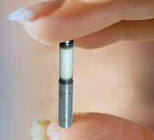| Critical & general care | |
New battery technology extends life of implantable medical devices5 October 2005 Madison, USA. New battery technology based on organosilicon that extends the life of lithium batteries has been developed by the University of Wisconsin - Madison. It will lead to longer lasting and smaller batteries for powering implantable devices such as defibrillators and the new breed of nerve microstimulators. The lithium battery is the workhorse in implantable devices — stimulators used to jump start the heart and help the central nervous system make critical connections in, for example, Parkinson's and epilepsy patients. Designed to be extraordinarily reliable and work continuously for years, the tiny batteries that power implantables are indispensable in everything from pacemakers to the electronic stimulators that help restore function in the brains of Parkinson's patients. But lithium batteries don't last forever and new surgery to maintain many devices seeded into the body is required, as it is to replace batteries and devices at the end of their lives. Moreover, a new generation of tiny electrical devices to stimulate the nervous system, treat incontinence and overcome muscular impairment is coming on line as scientists and engineers continue to shrink the components that make up the devices.
Using organosilicon compounds, West and his UW-Madison colleagues have developed a new generation of rechargeable lithium ion batteries whose lifetimes are more than twice as long as the batteries now used in the tiny medical devices. "It turns out the organosilicon compounds are really good for improving lithium battery technology," says West, whose new battery technology powers a "microstimulater" not much larger than a pencil lead and that can be injected near target nerves to help overcome the faulty nervous system wiring at the heart of Parkinson's, epilepsy and incontinence. "The idea is that whenever you have a broken nerve connection, you can supply the electrical impulse to complete the circuit," West explains. The microstimulator was developed by a consortium including UW-Madison's Organosilicon Research Center, Argonne National Laboratory, Advanced Bionics Corp., the Alfred Mann Foundation and Quallion, LLC. The device was recognized earlier this year with an "R&D 100 Award" from R&D Magazine. West's group developed the electrolyte, the electricity-conducting liquid that is the heart of the battery. The new organosilicon compounds developed by the Wisconsin chemists, says West, have numerous advantages over traditional lithium battery chemistry. "They're very flexible. They don't solidify. They're stable, nonflammable, non-toxic and they pose no threat to the environment," says West, an international authority on silicon chemistry. Silicon, the stuff computer chips are made of, is one of the Earth's most abundant elements. Organosilicons are compounds composed of silicon and other natural materials. In the context of the lithium battery, West's group has been making and testing "designer silicons" that are specially formulated to conduct electricity in a very compact environment. In the lithium battery, charge is maintained as lithium ions flow between the battery's positive and negative electrodes. "The battery requires something the ions can go through easily. We had to tweak the (organosilicon) molecules to get higher conductivity and stability," says West. A critical advantage of the new battery technology is lifespan: "If you're going to implant these things, you want a (battery) lifetime of at least 10 years," says West, whose organosilicon batteries are projected to power the tiny implantable devices for more than 12 years. In addition to implantable devices for medicine, lithium batteries are used in scores of applications, from spacecraft to iPods. Patented through the Wisconsin Alumni Research Foundation, the new organosilicon compound technology is also being developed through a new start-up company, Polyron, Inc. The work to develop the new organosilicon compounds was funded by the National Institute of Standards and Technology, a federal technology agency that works with industry to develop and apply technology, measurements and standards. For more information: University of Wisconsin-Madison: www.wisc.edu |
 A
tiny microstimulator, a device that effectively jump-starts broken nerve
connections in conditions like Parkinson's, epilepsy and incontinence. The
device was developed by a consortium including UW-Madison’s Organosilicon
Research Center, Argonne National Laboratory, Advanced Bionics Corp., the
Alfred Mann Foundation and Quallion, LLC. It was recognized earlier in 2005
with an “R&D 100 Award” from R&D magazine.
A
tiny microstimulator, a device that effectively jump-starts broken nerve
connections in conditions like Parkinson's, epilepsy and incontinence. The
device was developed by a consortium including UW-Madison’s Organosilicon
Research Center, Argonne National Laboratory, Advanced Bionics Corp., the
Alfred Mann Foundation and Quallion, LLC. It was recognized earlier in 2005
with an “R&D 100 Award” from R&D magazine. Central
to that ability, according to University of Wisconsin-Madison Professor
Emeritus of Chemistry Robert West, is new lithium battery technology,
technology capable of making batteries smaller, last longer and, soon,
accept a charge from outside the body without the need for surgery.
Central
to that ability, according to University of Wisconsin-Madison Professor
Emeritus of Chemistry Robert West, is new lithium battery technology,
technology capable of making batteries smaller, last longer and, soon,
accept a charge from outside the body without the need for surgery.